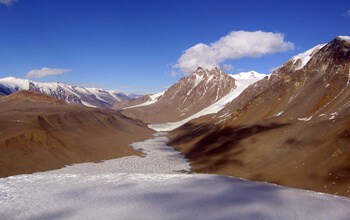A single season of intense melting that affected Antarctica between 2001 and 2002 offers new insights into the southernmost continent’s ecological future and the potential impact of climate change worldwide, according to observations collected in a series of papers and published this month in the journal BioScience.
The scientists are affiliated with two long-term research stations in Antarctica funded by the National Science Foundation (NSF). The location of the stations, one on the Antarctic coast and the other in a cold desert region of the continent, allowed researchers to compare the effects of a warmer, windier spring season brought on by the intersection of two climatic cycles — the Southern Annular Mode and the El Nino-Southern Oscillation — on two different ecosystems.
“These two vastly different polar ecosystems offer insights into how diverse ecosystems around the world will respond to climate change,” said Hugh Ducklow, an ecologist at Columbia University who leads the NSF-funded Long-Term Ecological Research (LTER) project at Palmer Station, one of the two research stations. “With long-term studies already in place, we were able to observe the effects on so many different levels.”
The Palmer LTER project, established with NSF funding in 1990, focuses on the ways changing sea-ice extent influences marine ecology and the multi-layered food webs of the coastal, nearshore and continental slope ecosystems. The McMurdo Dry Valleys LTER project, established in 1992, explores the ecology of the terrestrial and freshwater ecosystems of Antarctica’s McMurdo Dry Valleys — an ice-free polar desert where glacial meltwater exerts a profound influence on the ecosystem.
In addition to the LTER sites, NSF manages the U.S. Antarctic Program, the nation’s research program on the continent.
Between 2001 and 2002, atmospheric conditions at the coast-based Palmer Station resulted in thicker sea ice compacted against the edge of the peninsula, with increased melting that released large quantities of fresh water and ice algae directly into the upper mixed layer of the ocean. Nutrient inputs from the melting supported a large spring algae bloom and a resulting population boom of Antarctic krill, a major food source for penguins, whales, seals, fish and seabirds.
The same atmospheric patterns delivered greater snowfall and earlier spring snowmelt to the coastal region along the peninsula, flooding the nests of early-hatching Adelie penguins and lending an advantage to later-nesting gentoo and chinstrap penguins.
Farther south in the McMurdo Dry Valleys, the sudden arrival of a warm, dry wind rapidly melted mountain glaciers, delivering water across the parched landscape while scouring streambeds, raising lake levels, and uncovering windblown dust deposits hidden in glaciers. The characteristic thick layer of lake ice (typically 4 to 6 meters) also thinned rapidly, allowing more sunlight than usual to reach the upper layers of the plankton community that thrives in the lake water under the ice.
Inputs of dissolved organic carbon from newly active streams also stimulated increased bacterial productivity deeper in the lakes. Hints from genomic data suggest that these changes could drive long-term alterations in the structure of the lakes’ microbial communities.
At Palmer LTER, the physical effects of the 2001-2002 climate anomaly were transient. At McMurdo, the single season of warming marked the start of almost a decade of rising lake levels.
Papers featured in a special section of the October issue of BioScience include:
- Unravelling Ecosystem Responses to Climate Change on the Antarctic Continent Through Long Term Ecological Research, John C. Priscu.
- The Impact of a Large-Scale Climate Event on Antarctic Ecosystem Processes, Andrew G. Fountain, Grace Saba, Byron Adams, Peter Doran, William Fraser, Michael Gooseff, Maciek Obryk, John C. Priscu, Sharon Stammerjohn, and Ross A. Virginia.
- Responses of Antarctic Marine and Freshwater Ecosystems to Changing Ice Conditions, Maciej K. Obryk, Peter T. Doran, Ari S. Friedlaender, Michael Gooseff, Wei Li, Rachael Morgan-Kiss, John C. Priscu, Oscar Schofield, Sharon E. Stammerjohn, Deborah K. Steinberg, and Hugh W. Ducklow.
- Microbial Community Dynamics in Two Polar Extremes: The Lakes of the McMurdo Dry Valleys and the West Antarctic Peninsula Marine Ecosystem , Jeff S. Bowman, Trista J. Vick-Majors, Rachael Morgan-Kiss, Cristina Takacs-Vesbach, Hugh W. Ducklow, and John C. Priscu.

